Federated States of Micronesia mythology
Anagumang was a (probably legendary) Yapese navigator who led an expedition in rafts and canoes five or six hundred years ago. On this expedition he discovered the islands of Palau, where he and his men first saw limestone.
Anulap is a god of magic and knowledge in Truk Islands mythology an island group between Yap and Pohnpei in Micronesia (Truk), who teaches these things to humanity. He is the husband of the creator goddess Ligobubfanu, and may be a creator deity himself.
Isokelekel (Pohnpeian: "shining noble," "wonderful king"), [2] also called Idzikolkol, was a semi-mythical hero warrior from Kosrae who conquered the Saudeleur rulers of Pohnpei, an island in the modern Federated States of Micronesia, sometime between the early 16th century and early 17th century. [3] [note 1] Some Kosraean variants name this hero Nanparatak, with features closer to Ulithian tales of the same archetype. [7] He is considered the father of modern Pohnpei. [6]
Olifat [8] was a trickster god in Micronesian mythology. Olifat was the grandson of the god Anulap, the son of the god Lugeleng and the mortal Tarisso. Tarisso was the daughter of the octopus goddess Hit. When Lugeleng's wife attempted to prevent his union with Tarisso, Hit danced so lewdly that the woman fainted from arousal and had to be carried back to the sky, thus permitting Olifat's conception. [9] [10]
Kiribati mythology
Auriaria is a red-haired giant chieftain who fell in love with the beautiful red-haired woman, Nei Tituaabine, but they had no children. Nei Tituaabine died and from her grave grew three trees—a coconut from her head, a pandanus from her heels and an almond from her navel. She became a tree goddess.
Kai-n-Tiku-Aba ("tree of many branches") is a sacred tree located in Samoa, which grew on the back of a man named Na Abitu. Koura-Abi, a destructive man, broke it. Sorrowful, the people of Samoa scattered across the world.
Uekera is a tree that reaches to the heavens, the "tree of knowledge" in Kiribati legend. It is said to have been planted in Buariki village in North Tarawa by Nei Tekanuea. It is the inspiration for the name of the Kiribati weekly newspaper, Te Uekera.
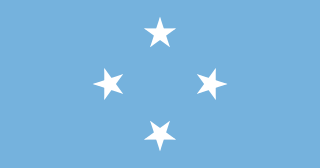
The Federated States of Micronesia, or simply Micronesia, is an island country in Micronesia, a subregion of Oceania. The federation consists of four states—from west to east, Yap, Chuuk, Pohnpei and Kosrae—that are spread across the western Pacific. Together, the states comprise around 607 islands that cover a longitudinal distance of almost 2,700 km (1,700 mi) just north of the equator. They lie northeast of Indonesia and Papua New Guinea, south of Guam and the Marianas, west of Nauru and the Marshall Islands, east of Palau and the Philippines, about 2,900 km (1,800 mi) north of eastern Australia, 3,400 km (2,100 mi) southeast of Japan, and some 4,000 km (2,485 mi) southwest of the main islands of the Hawaiian Islands.

The Federated States of Micronesia are located on the Caroline Islands in the western Pacific Ocean. The history of the modern Federated States of Micronesia is one of settlement by Micronesians; colonization by Spain, Germany, and Japan; United Nations trusteeship under United States-administered Trust Territory of the Pacific Islands; and gradual independence beginning with the ratification of a sovereign constitution in 1979.

Pohnpei is an island of the Senyavin Islands which are part of the larger Caroline Islands group. It belongs to Pohnpei State, one of the four states in the Federated States of Micronesia (FSM). Major population centers on Pohnpei include Palikir, the FSM's capital, and Kolonia, the capital of Pohnpei State. Pohnpei is the largest island in the FSM, with an area of 334 km2 (129 sq mi), and a highest point of 782 m (2,566 ft), the most populous with 36,832 people, and the most developed single island in the FSM.
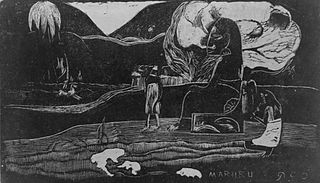
Hina is the name assigned to a number of Polynesian deities. The name Hina usually relates to a powerful female force who has dominion over a specific entity. Some variations of the name Hina include Sina, Hanaiakamalama, and Ina. Even within a single culture, Hina could refer to multiple goddesses and the distinction between the different identities are not always clear. In Hawaiian mythology, the name is usually paired with words which explain or identify the goddess and her power such as Hina-puku-iʻa (Hina-gathering-seafood) the goddess of fishermen, and Hina-ʻopu-hala-koʻa who gave birth to all reef life.
Nei Tituaabine, is a red-haired maiden with eyes bright as lighting in Micronesian mythology, specifically in Kiribati. Her appearance in mythology is heralded by a flash of lightning.
In the Micronesian mythology of Kiribati Uekera is a tree that reaches to the heavens; Te Kaintikuaba which is translated as the "tree of life" or "tree of knowledge" in Kiribati legend. It is said to have been planted in Buariki village in North Tarawa by Nei Tekanuea. The creation story is that spirits who lived in Te Kaintikuaba in Samoa, migrated northward carrying branches from the tree and created the islands of Tungaru. It is the inspiration for the name of the Kiribati weekly newspaper, Te Uekera.
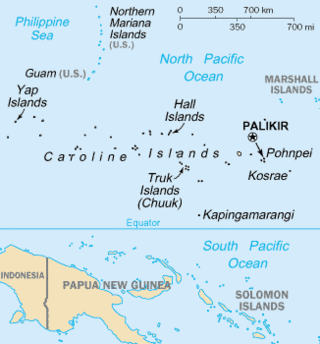
The Caroline Islands are a widely scattered archipelago of tiny islands in the western Pacific Ocean, to the north of New Guinea. Politically, they are divided between the Federated States of Micronesia (FSM) in the central and eastern parts of the group, and Palau at the extreme western end. Historically, this area was also called Nuevas Filipinas or New Philippines, because they were part of the Spanish East Indies and were governed from Manila in the Philippines.

The flag of the Federated States of Micronesia was adopted on 30 November 1978. The blue field represents the Pacific Ocean. In an echo of U.S. heraldic practice, the stars represent the four federated states: Chuuk, Pohnpei, Kosrae and Yap, arranged like the points of the compass.
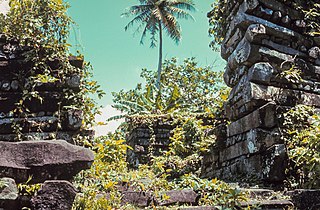
Nan Madol is an archaeological site adjacent to the eastern shore of the island of Pohnpei, now part of the Madolenihmw district of Pohnpei state in the Federated States of Micronesia in the western Pacific Ocean. Nan Madol was the capital of the Saudeleur dynasty until about 1628. The city, constructed in a lagoon, consists of a series of small artificial islands linked by a network of canals. The site core with its stone walls encloses an area approximately 1.5 km long by 0.5 km wide and it contains 92 artificial islets—stone and coral fill platforms—bordered by tidal canals.
In Polynesian mythology, Tuna is a god of eels. In Hawaiian mythology he fights with Māui, who is having an affair with his wife Hina. Māui kills him, cuts off his head, and plants it near his home. A green shoot emerges from the spot where the head was buried, and grows into the first coconut palm. In the mythology of Mangaia Tuna is the lover of Hine, and asks that his head be cut off and planted in order to stop a flood. A coconut shoot grows from the head. A variant of the story is told in the Samoan myth of Sina and the Eel.
Anulap is a sky god in the mythology of the island of Truk in Micronesia. He is the husband of the creator goddess Ligobubfanu. Their son was Lugeilan, and their grandson was Olifat.
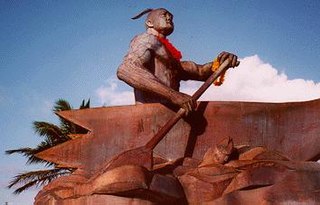
Gadao is a legendary chief of the village of Inarajan in southern Guam. In the Chamorro language of ancient Guam, he would have had the title maga'lahi as a high-ranking male. In addition to being featured in legend, he is the namesake of Inarajan's Chief Gadao's Cave containing ancient cave paintings. Some stories claim Gadao himself drew the figures.

The Senyavin Islands belong to Pohnpei State in the Federated States of Micronesia. They consist of a larger volcanic Pohnpei Island and two small atolls Ant and Pakin.

The Saudeleur dynasty was the first organized government uniting the people of Pohnpei island, ruling from c. 1100-1200 CE to c. 1628 CE. The era was preceded by the Mwehin Kawa or Mwehin Aramas, and followed by Mwehin Nahnmwarki. The name Deleur was an ancient name for Pohnpei, today a state containing the capital of the Federated States of Micronesia.

Rota Latte Stone Quarry, also known as the As Nieves quarry, is located near the Chamorro village of Sinapalo, on the island of Rota in the Marianas Archipelago. The prehistoric megaliths found there are believed to have been used as foundation pillars for houses, with some of them weighing up to 35 tons. Their exact age, origin, methods of quarrying and means of transportation have not been determined.

The House of Taga is an archeological site located near San Jose Village, on the island of Tinian, United States Commonwealth of the Northern Mariana Islands, in the Marianas Archipelago. The site is the location of a series of prehistoric latte stone pillars which were quarried about 4,000 feet (1,200 m) south of the site, only one of which is left standing erect due to past earthquakes. The name is derived from a mythological chief named Taga, who is said to have erected the pillars as a foundation for his own house.
Isokelekel, also called Idzikolkol, was a semi-mythical hero warrior from an island east of Pohnpei who conquered the Saudeleur Dynasty of Pohnpei, an island in the modern Federated States of Micronesia, with the help of the indigenous people of Pohnpei sometime between the early 16th century and early 17th century. Some Kosraean variants name this hero Nanparatak, with features closer to Ulithian tales of the same archetype. He is considered the father of modern Pohnpei.
Olifat is a trickster god in Micronesian mythology.

Gadao's Cave, also known as Liyang Gadao, is a rock art site on the United States island of Guam. Located near the village of Inarajan, the cave is the site of a panel of approximately 50 Chamorro pictographs, painted with a mixture of coral lime and tree sap. The most unusual images are of two human stick figures that appear to be carrying things. It is not known who painted them or when, and what their significance is. The legendary chief of Inarajan Gadao is believed to be the creator of the cave's images.

The Church of Jesus Christ of Latter-day Saints in the Federated States of Micronesia refers to the Church of Jesus Christ of Latter-day Saints and its members in the Federated States of Micronesia (FSM). The church's first known missionaries arrived on July 5, 1978. As of December 31, 2022, there were 5,966 members in 23 congregations in FSM. The LDS Church has congregations in every state in the FSM.










